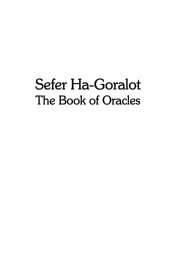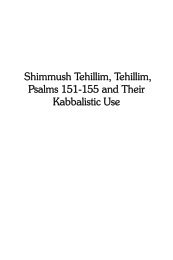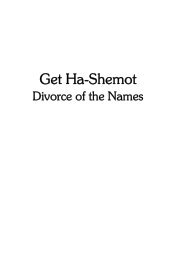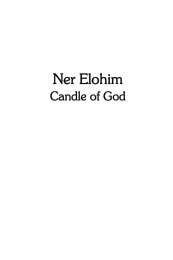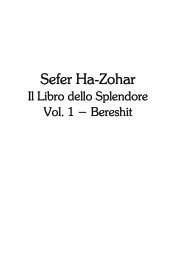Pardes Rimonim – Orchard of Pomegranates - EverburningLight.org
Pardes Rimonim – Orchard of Pomegranates - EverburningLight.org
Pardes Rimonim – Orchard of Pomegranates - EverburningLight.org
You also want an ePaper? Increase the reach of your titles
YUMPU automatically turns print PDFs into web optimized ePapers that Google loves.
<strong>Pardes</strong> <strong>Rimonim</strong><strong>Orchard</strong> <strong>of</strong> <strong>Pomegranates</strong>Parts 1-4
Your purchase helps usto sponsor a new translation
<strong>Pardes</strong> <strong>Rimonim</strong><strong>Orchard</strong> <strong>of</strong> <strong>Pomegranates</strong>Parts 1-4By Moshe CordoveroTranslated by Elyakim GetzIntegral edition in English, Hebrew, and AramaicE-mail: info@everburninglight.<strong>org</strong>WWW: http://www.everburninglight.<strong>org</strong>
Publisher: Providence UniversityFirst edition, 2007ISBN: 1-897352-17-4Copyright © 2007 by Fabrizio Lanza, ULC-ITALIAFor information:ULC-ITALIAVia C.A. Colombo 20/F, 34074 Monfalcone (GO)Tel.: +39-(0)481-412574All rights reserved for every country. No part <strong>of</strong> this publication may bereproduced, stored in a retrieval system, or transmitted in any form or by anymeans, electronic, mechanical, photocopying, recording or otherwise, withoutthe prior permission <strong>of</strong> the publisher.Printed in the United States <strong>of</strong> America.
<strong>Pardes</strong> <strong>Rimonim</strong> <strong>–</strong> <strong>Orchard</strong> <strong>of</strong> <strong>Pomegranates</strong> vIndex <strong>of</strong> contentsIndex <strong>of</strong> contentsvPrefaceixAuthor’s Introduction 1Part 1: The First Treatise is called “Ten and not Nine” 3Chapter 1 3Chapter 2 8Chapter 3 15Chapter 4 21Chapter 5 24Chapter 6 29Chapter 7 35Chapter 8 39Chapter 9 41Chapter 10 45Part 2: The Second Treatise is “The reason for theemanation ,אצילות) Azilut)” 50Chapter 1 50Chapter 2 56Chapter 3 61Chapter 4 69Chapter 5 76Chapter 6 80
vi<strong>Pardes</strong> <strong>Rimonim</strong> <strong>–</strong> <strong>Orchard</strong> <strong>of</strong> <strong>Pomegranates</strong>Chapter 7 85Part 3: The Third Treatise is called “Is the InfiniteCrown?” 95Chapter 1 95Chapter 2 101Chapter 3 104Chapter 4 110Chapter 5 116Chapter 6 123Chapter 7 128Chapter 8 135Part 4: The Fourth Treatise is called “Substance andvessels” 145Chapter 1 145Chapter 2 151Chapter 3 158Chapter 4 162Chapter 5 168Chapter 6 176Chapter 7 185Chapter 8 198Chapter 9 205Chapter 10 213The original text in Hebrew 224224 אשער א פרק
<strong>Pardes</strong> <strong>Rimonim</strong> <strong>–</strong> <strong>Orchard</strong> <strong>of</strong> <strong>Pomegranates</strong> vii226 ב שער א פרק229 ג שער א פרק231 ד שער א פרק233 ה שער א פרק235 ו שער א פרק238 ז שער א פרק239 ח שער א פרק241 ט שער א פרק242 י שער א פרק244 א שער ב פרק247 ב שער ב פרק249 ג שער ב פרק253 ד שער ב פרק256 ה שער ב פרק257 ו שער ב פרק260 ז שער ב פרק264 א שער ג פרק267 ב שער ג פרק268 ג שער ג פרק270 ד שער ג פרק273 ה שער ג פרק276 ו שער ג פרק278 ז שער ג פרק281 ח שער ג פרק
viii <strong>Pardes</strong> <strong>Rimonim</strong> <strong>–</strong> <strong>Orchard</strong> <strong>of</strong> <strong>Pomegranates</strong>285 א שער ד פרק288 ב שער ד פרק291 ג שער ד פרק293 ד שער ד פרק296 ה שער ד פרק299 ו שער ד פרק303 ז שער ד פרק309 ח שער ד פרק312 ט שער ד פרק315 י שער ד פרק
<strong>Pardes</strong> <strong>Rimonim</strong> <strong>–</strong> <strong>Orchard</strong> <strong>of</strong> <strong>Pomegranates</strong> ixPreface<strong>Pardes</strong> <strong>Rimonim</strong> is a classic work <strong>of</strong> authentic Kabbalahpenned by the preeminent scholar, Rabbi MosheCordevero (Ramak).A powerful intellect, fertile writer, and gigantic figure inKabbalah, Ramak (circa 1520-1570) distinguished himselffirst in Talmudic studies while under the tutelage <strong>of</strong> RabbiYosef Caro. However, he began his Kabbalah studies atage 20 with Rabbi Shlomo Alkabetz, who was both hisbrother-in-law and composer <strong>of</strong> Lecha Dodi.In the <strong>Pardes</strong>, Ramak also displays a markedphilosophical influence by the Rambam (Rabbi Moshe BenMaimon, i.e. Maimonides), as evidenced in his rationalapproach to the subject matter, his choice <strong>of</strong> terminology,and by his great care in the use <strong>of</strong> language that defendsthe Divine ‘incorporeality’ <strong>of</strong> the Deity. Indeed, Ramak’sencyclopedic work in Kabbalah heralded the renaissance <strong>of</strong>kabbalistic genius that emerged after him in Safed.A comprehensive work collecting the kabbalistic learning<strong>of</strong> that time, the original Hebrew version <strong>of</strong> the <strong>Pardes</strong> wasa single volume composed <strong>of</strong> 32 parts and was written inboth Hebrew and Aramaic. This present English translation<strong>of</strong> <strong>Pardes</strong> <strong>Rimonim</strong> consists <strong>of</strong> four parts and is dividedinto treatises, and chapters.Of the four treatises published in this volume, Ramakdesignates the first as “Ten and not Nine”. It consists <strong>of</strong> 10chapters. Referencing the Sefer Yezirah and “those whoare involved in the hidden wisdom”, he underlines theagreement that there are only 10 Sefirot, therebyestablishing at the outset their numerical integrity. Not onlyare the Sefirot 10 in number, but also Bli Mah, i.e. without
x<strong>Pardes</strong> <strong>Rimonim</strong> <strong>–</strong> <strong>Orchard</strong> <strong>of</strong> <strong>Pomegranates</strong>substance, materiality or physical limits. This is important,for the Sefirot are understood as God’s attributes; and justas the Deity is incorporeal, without material limitations orboundaries, so too are His attributes − the Sefirot.The second treatise is called “The Reason for theemanation”, consisting <strong>of</strong> 7 chapters. In chapter 1 <strong>of</strong> thistreatise, Ramak addresses Rabbi Yehudah 'Hayat’s critique<strong>of</strong> Rabbi Azriel’s statement − wherein he attempts toestablish the number <strong>of</strong> Sefirot as 10, while referring to aSefira as a point and ascribing to it geometrical dimension− that it has “…three dimensions, length, width, anddepth; and when you multiply it by itself, three becomesnine, which − together with the space that contains them− make ten”. The basis for Rabbi Yehudah’s criticism isthat dimension entails quantity; and since a Sefira is anattribute <strong>of</strong> God − Who is without the limits <strong>of</strong> dimensionor quantity − attributing dimension to a Sefira impliescorporeality in the Deity. Ramak brings further clarity to theissue by explaining that the Sefirot have no share inmateriality, but rather, after bodies are derived from them,then the “Sefirot are their [bodies] roots to which we applythe terms <strong>of</strong> materiality only by synonym”.In the third treatise, called “Is the Infinite Crown?”,Ramak speaks to the confusion displayed by somekabbalists who make the Upper Crown (Keter)synonymous with the Infinite (Ein S<strong>of</strong>), and by implicationmake Ein S<strong>of</strong> one <strong>of</strong> the 10 Sefirot. Ramak rejects thisnotion with support drawn from scripture and logic,arguing that the Emanator is essentially distinct from theemanation in that the emanated are subject to the limits <strong>of</strong>time. He says <strong>of</strong> the Deity that, “One <strong>of</strong> the things aboutthe Infinite is that it is impossible that He does not exist. Heis the necessary existent Who brought time into existence,
<strong>Pardes</strong> <strong>Rimonim</strong> <strong>–</strong> <strong>Orchard</strong> <strong>of</strong> <strong>Pomegranates</strong> xibut He is not subject to time”. He also quotes Yigdal: “Heis first, but there is no beginning to His beginning”. Ratherthe Infinite is the First <strong>of</strong> all that that comes after. In thisway, Ramak establishes that Keter is one among theemanated.The fourth treatise is entitled “Substance and vessels”,and has 10 chapters that deal with the question <strong>of</strong> whetherthe Sefirot are ‘co-substantial’ with the Emanator orwhether they are merely vessels. He begins essentially witha survey <strong>of</strong> Rabbi Mena’hem Recanati’s view <strong>of</strong> the matter,which is, in effect, that the Creator and the Sefirot are notco-substantial. Rather, the Sefirot are vessels into which“the Creator’s great light” shines, and the influx into themis an emanation. Ramak contrasts this perspective with theview that alleges the co-substantiality <strong>of</strong> the Deity and theSefirot. For this he cites Rabbi David’s book Magen David.Ramak then follows this with a perspective derived fromthe Zohar wherein he maintains, “These Sefirot are ahigher soul dressing into the ten Sefirot called by namesthat are vessels. In other words, the ten substantial Sefirotare the brain and the higher soul <strong>of</strong> the ten vessels”.Ramak ends by explaining that the names, attributes, andepithets mirror the actions <strong>of</strong> the Creator, and are all forthe sake <strong>of</strong> His creatures, for, “If not for them, why shouldHe be called ‘Merciful’ or ‘Judge’?” Thus, it is not that theCreator ‘has’ attributes or names. Nonetheless, it is bythese attributes that the Creator spreads His influence intothe world and thereby governs all its creatures.Talib Din
<strong>Pardes</strong> <strong>Rimonim</strong> <strong>–</strong> <strong>Orchard</strong> <strong>of</strong> <strong>Pomegranates</strong> 1Author’s IntroductionThus says Moshe, the son <strong>of</strong> Ya‘aqov Cordovero. I sawthat the days <strong>of</strong> childhood were a hopless pursuit <strong>of</strong> desire,until I reached my twentieth birthday. As my beard turnedbrown, the Creator aroused me as a man awakening fromhis slumber. I said then to my soul: How long will you befoolish and indulge in drunkenness? How long will younurture wicked thoughts and f<strong>org</strong>et your Creator? Awakenow and call unto your God, visit His gates daily andrepair His broken altar. My soul heard the call andanswered: I shall rise and go through the streets <strong>of</strong> the citylooking for some remedy. I then heard the voice <strong>of</strong> the holyangel who descended upon earth, my teacher and master,the divine kabbalist, the wise Rabbi Shlomo Alkabetz, whobrought me into the sanctuary <strong>of</strong> His palace and taughtme. He said to me: My son, let my words comfort yourheart, bend your ear, and listen to the words <strong>of</strong> the sages.He established me at the gates <strong>of</strong> wisdom andunderstanding − sweeter than honey − reaching to thedepth <strong>of</strong> mysteries <strong>of</strong> the Torah. These were like honey tome and I studied diligently with him. He taught me theways <strong>of</strong> the Zohar and handed me the keys to its gates. Istrengthened myself and learned for days withastonishment, saying: How good and sweet is this learning.I became a son <strong>of</strong> this wisdom and her breasts fed mewhenever I thirsted; and I shall never f<strong>org</strong>et it. As I waslearning, I set before me all the books <strong>of</strong> the divineRashb”y and pondered upon them. My heart was as if inthe mist <strong>of</strong> the sea, and I was confused by the depth <strong>of</strong> themany investigations. I said to myself: Let me take scribe’sinkwell and <strong>org</strong>anize the investigations into categories inorder to ease my mind. I saw from heaven that this counsel
2 <strong>Pardes</strong> <strong>Rimonim</strong> <strong>–</strong> <strong>Orchard</strong> <strong>of</strong> <strong>Pomegranates</strong>was straight and right before the Almighty, and I started toinscribe a scroll as a reminder. I called it an orchard(<strong>Pardes</strong>) for various reasons. Firstly, the esoteric wisdom(Kabbalah) is called so. Secondly, since this scroll willrestore my soul in this world and in the next, it is theorchard that I planted and where I shall delight. Its treatisesare its shoots, its chapters its pomegranates. There, newinterpretations are arranged orderly like the seeds <strong>of</strong> thepomegranate. So it is called the <strong>Orchard</strong> <strong>of</strong> <strong>Pomegranates</strong>(<strong>Pardes</strong> <strong>Rimonim</strong>).We saw fit to divide this scroll into thirty-two treatises.These are the gates leading to the esoteric teachings <strong>of</strong> theTorah and its mysteries. Furthermore, we have divided thetreatises into chapters − some lengthy and others short −all according to the size <strong>of</strong> the investigation. We beg thereader not to enter the treatises without the tables <strong>of</strong>contents and the order <strong>of</strong> the chapters, unless God forbid,harm should incur instead <strong>of</strong> pr<strong>of</strong>it. We assure thatwhoever follows this table <strong>of</strong> contents will gain morecomprehension in this wisdom. However, nobody shouldthink that only reading the explanations twice is enough,for the work is great. Likewise, nobody should leave achapter until he knows it well, for even if we do not repeatourselves, we rely on the previous chapter. Therefore, donot leave a treatise for the next one unless it is wellunderstood. Then, you will walk securely and without fear.All this being said, we will not refrain from writing againwhat we already wrote somewhere else.



